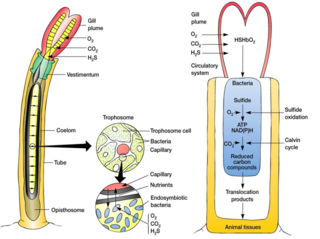
A trophosome is a highly vascularised organ found in some animals that houses symbiotic bacteria that provide food for their host. Trophosomes are contained by the coelom of tube worms and in the body of symbiotic flatworms of the genus Paracatenula.
Inanidrilus is a genus of marine annelid worms, first described by Christer Erséus in 1979. They are gutless and live in the interstitial of tropical and subtropical seas.

Paracatenula is a genus of millimeter sized free-living marine gutless catenulid flatworms.
Heronidrilus gravidus is a species of oligochaete worm, first found in Belize, on the Caribbean side of Central America.
Inanidrilus reginae is a species of clitellate oligochaete worm in the family Naididae. It was first found in Belize, on the Caribbean side of Central America. It lives in subtidal sand with seagrass.
Olavius finitimus is a species of oligochaete worm, first found in Belize, on the Caribbean side of Central America.
Olavius vacuus is a species of oligochaete worm, first found in Belize, on the Caribbean side of Central America.
Olavius pravus is a species of clitellate oligochaete worm, first found in Belize, on the Caribbean side of Central America.
Bathydrilus egenus is a species of clitellate oligochaete worm, first found in Belize, on the Caribbean side of Central America.
Thalassodrilides bruneti is a species of oligochaete worm, first found in Belize, on the Caribbean side of Central America.
Limnodriloides anxius is a species of clitellate oligochaete worm, first found in Belize, on the Caribbean side of Central America.
Smithsonidrilus appositus is a species of oligochaete worm, first found in Belize, on the Caribbean side of Central America.

Kentrophoros is a genus of ciliates in the class Karyorelictea. Ciliates in this genus lack a distinct oral apparatus and depend primarily on symbiotic bacteria for their nutrition.
Stilbonematinae is a subfamily of the nematode worm family Desmodoridae that is notable for its symbiosis with sulfur-oxidizing bacteria.
Astomonema is a genus of nematode worms in the family Siphonolaimidae. They lack a mouth or conventional digestive tract, but contain symbiotic sulfur-oxidizing bacteria that serve as their primary food source. They live in the marine interstitial habitat.
Nicole Dubilier is a marine microbiologist and director of the Symbiosis Department at the Max Planck Institute for Marine Microbiology since 2013 and a Professor of Microbial Symbioses at the University of Bremen. She is a pioneer in ecological and evolutionary symbiotic relationships between sea animals and their microbial partners inhabiting environments that harbour low nutrient concentrations. She was responsible for the discovery of a new form of symbiosis between two kinds of bacteria and the marine oligochaete Olavius algarvensis.

All animals on Earth form associations with microorganisms, including protists, bacteria, archaea, fungi, and viruses. In the ocean, animal–microbial relationships were historically explored in single host–symbiont systems. However, new explorations into the diversity of marine microorganisms associating with diverse marine animal hosts is moving the field into studies that address interactions between the animal host and a more multi-member microbiome. The potential for microbiomes to influence the health, physiology, behavior, and ecology of marine animals could alter current understandings of how marine animals adapt to change, and especially the growing climate-related and anthropogenic-induced changes already impacting the ocean environment.

Olavius is a genus of oligochaete worms, first described by Christer Erséus in 1984.
Phallodrilinae is a subfamily of clitellate oligochaete worms.
Ainudrilus is a genus of clitellate oligochaete worms.





